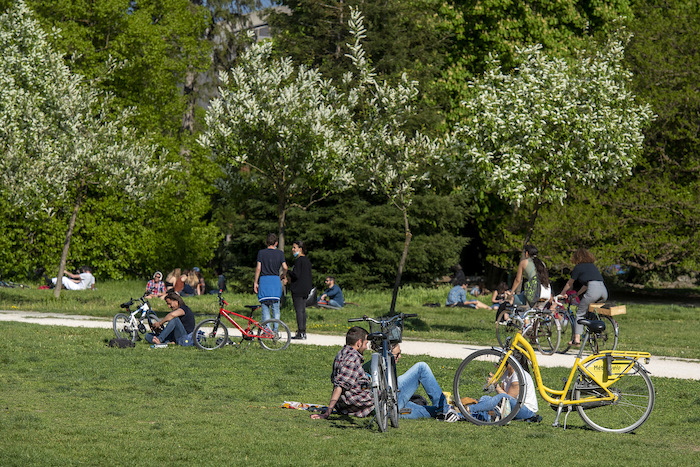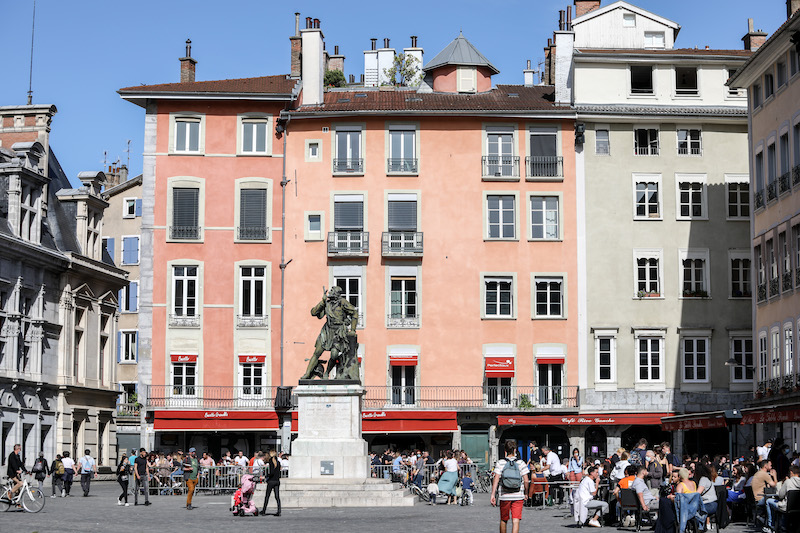BY LAURIANE BELLOT HANSON
Nestled comfortably at the foot of the French Alps, Grenoble elegantly balances urban vibrancy with natural splendor, rightly earning its reputation as one of Europe’s green capitals.
Often referred to as the “Capital of the Alps,” Grenoble lies at the confluence of the Drac and Isère rivers, surrounded by towering mountain ranges, making it a haven for outdoor enthusiasts and a hub of innovation and progress. Its unique geographic position and rich historical significance are complemented by its modern achievements in sustainable development and international collaboration, including its ongoing partnership as a sister city to Phoenix, Arizona.
PARTNERS IN SUSTAINABILITY
Despite significant geographical and climatic differences, both cities stand as global leaders in sustainability and urban innovation. Phoenix, situated amidst the arid landscape of the Sonoran Desert, has developed remarkable strategies for water conservation, renewable energy utilization, and heat mitigation — challenges quite distinct yet conceptually parallel to Grenoble’s alpine climate initiatives. Both cities prioritize eco-friendly urban transportation: Grenoble, through its extensive cycling paths, and Phoenix via its ever-expanding light rail system. Similarly, each city has championed energy innovation, with Phoenix becoming a global leader in solar power technology, and Grenoble capitalizing on hydroelectric power and pioneering energy-efficient building practices.
The two cities’ shared commitment goes beyond mere infrastructure, extending into cultural exchanges and educational partnerships. Collaborative initiatives and dialogue between Grenoble’s Université Grenoble Alpes and Arizona State University encourage innovation, particularly in renewable energy research and sustainable urban planning. Such exchanges reinforce each city’s dedication to addressing global environmental challenges, demonstrating how international cooperation can inspire meaningful local action.
DISCOVERING GRENOBLE’S ECO-FRIENDLY SPIRIT
Renowned for its dedication to sustainability, exceptional cycling paths, and pedestrian-friendly avenues, Grenoble invites visitors to immerse themselves in its environmentally conscious spirit. Begin your journey at Place Grenette, the city’s bustling heart. Here, elegant cafés invite travelers to pause for a morning espresso as they take in Grenoble’s lively atmosphere. Pedestrian zones spread outward, fostering Grenoble’s reputation for walkability and reducing reliance on vehicles, significantly lowering urban pollution — a value also shared by Phoenix, known for its investment in pedestrian-friendly urban renewal projects and expanding public transit networks.
From Place Grenette, stroll toward the historic center, guided by the gentle murmuring of the Isère River. The Old Town, or Vieille Ville, with its narrow, winding streets lined by ancient buildings, is best explored at a leisurely pace. Make your way to Place Saint-André, home to the former parliament building and the historic Saint-André church. This charming square offers a splendid view of Grenoble’s architectural heritage and is a pleasant space to rest amid historic surroundings.

Next, cross the picturesque Pont Saint-Laurent, pausing briefly to admire panoramic views of the surrounding mountains reflected in the river below. Here, Grenoble’s commitment to green spaces is immediately evident — extensive riverside parks invite locals and visitors alike to relax and rejuvenate amidst nature.
Upon crossing the river, follow signs toward the famed Bastille fortress, towering proudly over Descending from the Bastille, continue along Grenoble’s superb cycling paths toward Parc Paul Mistral, a verdant urban oasis. As Grenoble’s largest park, it epitomizes the city’s dedication to environmental sustainability and quality of life. Families, joggers, cyclists, and strollers share its shaded paths, beautifully landscaped lawns, and serene water features. Within the park stands the iconic Tour Perret, a symbol of Grenoble’s historical embrace of modernity and innovation.

Adjacent to the park lies Grenoble’s innovative and sustainably designed eco-district, the Caserne de Bonne. Once military barracks, this quarter now houses eco-friendly apartments, shops, and eateries, emphasizing Grenoble’s strategic commitment to green urban planning. Explore its pedestrianized streets, lush roof gardens, and buildings boasting energy-efficient technologies, clearly illustrating why Grenoble is celebrated as a green urban pioneer.
Grenoble also holds a distinctive historical legacy as the host city for the 1968 Winter
Olympics. This landmark event significantly shaped Grenoble’s urban landscape, leaving behind an innovative infrastructure legacy that the city has creatively transformed. Today, visitors can witness how the former Olympic venues have been repurposed sustainably, demonstrating the city’s forward- thinking approach to adaptive reuse. Notably, the Olympic ice rink, once bustling with competitive skaters, now thrives as the Palais des Sports, hosting cultural events, concerts, and local gatherings. Similarly, the Olympic Village, originally constructed to house athletes, has become a vibrant residential community, reflecting Grenoble’s commitment to urban sustainability and community integration.
Next, pedal or walk toward the Museum of Grenoble, one of France’s most prestigious art institutions, boasting a superb collection from classic masters to contemporary visionaries. The museum’s thoughtful architecture integrates natural light and green landscaping, reinforcing Grenoble’s deep respect for environmental harmony.

To conclude the itinerary, return to the city’s vibrant center, wandering toward Place Victor Hugo. Here, Grenoble’s ecological sensibility emerges again, with abundant greenery, carefully maintained flower beds, and benches providing ample opportunity to reflect on your day’s explorations.
Throughout this journey, Grenoble’s status as a green capital is unmistakably evident —from sustainable urban planning and widespread use of bicycles to extensive green spaces and nature- infused cityscapes. Like its sister-city of Phoenix, Grenoble serves as a dynamic model of sustainability and innovation, inviting visitors not only to enjoy its cultural richness and natural beauty but also to appreciate its progressive vision for a sustainable and resilient urban future.






